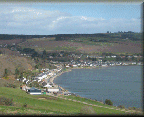As far back as 1914, the Medical Officer of Health was pointing out the need for tarring playgrounds, better wages for cleaners so that cleanliness could be improved, AND the need for oilskins for children in Lewis and the West Coast. Heating for schools was inadequate with almost all schools using open fires. Though a few schools used stoves, only 3 had hot piping in 1920. The MOH suggested that thermometers should be hung in all rooms with readings being recorded four times a day.
Lighting and ventilation were also unsatisfactory with the problem of opening old style windows to get rid of stale room smells, and yet retaining what little heat there was. If natural daylight was not sufficient, paraffin lamps were used for lighting, with the only suggestion for improvement being to rearrange the desks.
By 1923, electricity had come to Dingwall, Invergordon and Foddery only. Heating by hot water circulation in pipes was proving successful and justified the expense, though there was difficulty in looking after the pipes in frosty conditions. For this system of heating, it was recommended that fires be lit 2 hours before the opening of the school day and that stoking should cease 2 hours before dismissal.
In 1929, sanitary conveniences required urgent attention with the old pit system being regarded as unsatisfactory. This was replaced by the pail system which was considered an improvement. By 1927, the pit system was rapidly disappearing, but pail closets, using small capacity pails, required a very high standard of cleanliness. Reports mention that there were no separate toilet facilities for the staff!.
At this time, water carriage systems were not in use and the urinals had no water supply. Many schools relied on rain water tanks, the success of which depended on the weather. Seemingly there was no shortage of water in 1926!
As late as 1948 there were some rural schools which had no sanitary conveniences at all. Some schools were provided with chemical closets, while others had water carriage systems.
The MOH report of 1953 stated that WCs in schools were unsatisfactory as many were broken, soiled etc. In one school, 53 pupils, boys and girls, were sharing one toilet as the other was out of order! The increase in population meant that facilities were inadequate.
In 1925 the MOH was still suggesting the great need for gravel at all school entrances, since often the children had to wade through water and mud before entering the school.
In the 1920s, the MOH called for improved cleaning of schools and by 1930, “Dusmo” a cleanser, disinfectant and antiseptic was used universally throughout the area. Class seating arrangements were improved by 1930 when the old, backless desks were replaced by a new dual, backed desk.
In spite of these improvements, the MOH report of 1947 stated that the majority of schools were old, school hygiene was below standard and playgrounds became quagmires in wet weather. By 1948 the new Hydro-Electric Schemes were making an impact with some schools being connected. At this time there was a shortage of cleaners, but by 1954 most schools were wired for electricity with only the small schools having open fires. By 1960 almost all schools were benefiting from electricity.
